Seborrhea in Dogs: Causes, Treatments + Management
Remember, this is an educational resource, not a guide for diagnosis.
Pictures are helpful, but they may not tell the whole dermatological story. We always recommend consulting with your vet for any of your dog's health concerns.
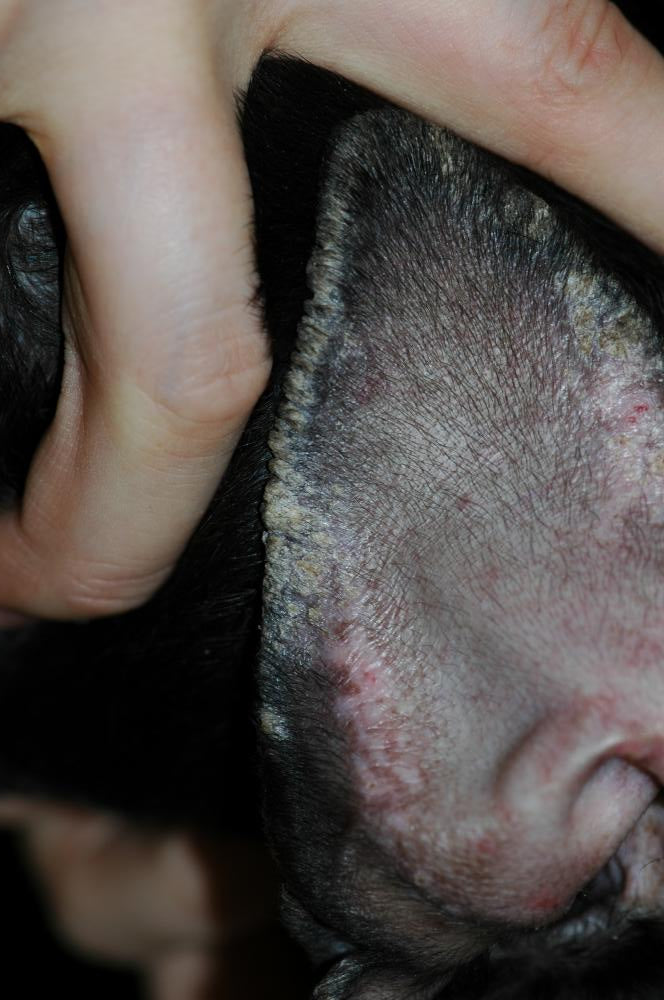
What is Seborrhea?
Seborrhea, or seborrheic dermatitis, is a skin disorder that involves an over-production or under-production of keratin - a protein that forms skin and hair. Keratin is continually produced in the body (keratinization) as the cells of the outer layer of skin are constantly dying, wearing off, and being renewed.
The keratinization cycle normally takes about 3 weeks, but in dogs with seborrhea, that cycle is greatly accelerated to a period of several days. This creates a keratin buildup on the skin, which resembles flakes (dandruff) or scales on the skin.
Seborrhea Sicca + Oleosa
Seborrhea comes in a couple of forms: seborrhea sicca (dry) and seborrhea oleosa (oily). Seborrhea sicca exhibits dry scaling and flaking skin, whereas seborrhea oleosa comes with scales and a greasy coat that tends to have a distinctive, bad smell. Dogs with seborrheic dermatitis may have both dry and oily forms, as well as inflammation.
Ear margin seborrhea; photo by Dr. Sheila Torres, DVM, via the Merck Veterinary Manual
Where Does Seborrhea Usually Occur?
Seborrhea tends to occur in areas rich with sebaceous glands (hence the name), including along the spine, flanks, neck, belly, skin folds, and ear margins. The sebaceous glands produce sebum, an oily substance that is naturally secreted onto the skin and hair, which helps protect and give a dog's coat its sheen.
Excessive amounts of sebum create scaly and often oily deposits on the skin that can result in greasy fur and a bad odor. On the other hand, a lack of sebum produced in the body can result in a dull, dry, lackluster coat.
Veterinarians tend to classify seborrhea as "primary" or "secondary" disease. Neither form is contagious to other dogs, animals, or humans.
Symptoms of Canine Seborrhea
- Very dry, lackluster coat
- Excessive dandruff
- Greasy, oily skin with bad odor
- Crusted, scaly skin buildups
- Large amounts of ear debris and wax
- Mild to severe itching (pruritis)
- Note: Primary seborrhea is not itchy; secondary seborrhea exhibits itching, but it is often due to an underlying allergy or infection.
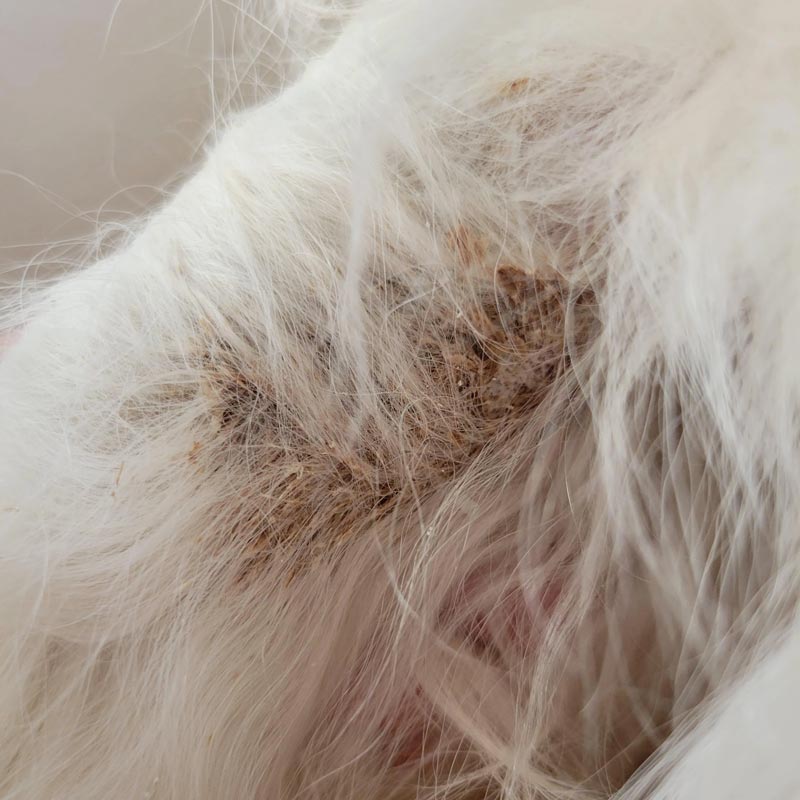
Primary Seborrhea in Dogs
Primary seborrhea - sometimes called idiopathic seborrhea - is a rare, genetically inherited disease. Similar to demodectic mange (or demodex, a parasitic disease that affects the hair follicles), it is not contagious to other dogs, and there is typically a family history of the disorder. Dogs that carry primary seborrhea (or demodex) should not be bred.
Primary seborrhea shows itself at a young age (18-24 months) and lasts throughout the dog's life. It does not tend to be pruritic (itchy). Diagnosing this form can take time and testing if the medical histories of a dog's parents are unknown, as all possible underlying causes or similar skin conditions must be excluded.
Photo: Seborrhea on English Cream Retriever, via r/luna8tuna on Reddit
How Is Primary Seborrhea Treated?
There is currently no cure for primary seborrhea. It is a lifelong condition that requires continual care to reduce keratin buildup and the risk of bacterial (pyoderma) or yeast (Malassezia) infection.
These dogs will require frequent bathing (1-2 times per week) with medicated keratolytic shampoos that typically contain coal tar, sulfur, and salicylic acid to remove the excess keratin and degrease the skin and coat. Frequent ear cleaning - every 2-3 days - with a medicated ear cleaner may also be necessary.
On top of that, dogs with primary or idiopathic seborrhea may also require Vitamin A supplementation. Lastly, and most importantly, these dogs will need regular veterinary visits.
Secondary Seborrhea in Dogs
The vast majority of dogs with seborrhea have the secondary form. It is called "secondary" since it is an effect of another underlying health issue(s), and it can affect any breed of dog at any age.
Causes of Secondary Seborrhea
Allergies
- Environmental
- Food allergies and sensitivities
- Contact with an irritating substance (contact dermatitis)
Parasites
Infection
Hormonal Disorder
- Hypothyroidism
- Cushing's disease
Other
- Diabetes mellitus
- Poor nutrition
- Autoimmune diseases, such as sebaceous adenitis and lupus erythematosus
- Cancers, such as epitheliotropic lymphoma
Breeds Commonly Affected by Seborrhea
Diagnosing Canine Seborrhea
Veterinary diagnosis begins comprehensive physical and dermatological examination and a review of the dog's medical history. Since the great majority of seborrhea cases are secondary to another issue(s), your veterinarian will look for any other symptoms to pinpoint the problem.
Your vet will ask about how long the problem has been happening, whether your dog has been chewing or scratching, if your dog has any known skin allergies, and whether there have been any changes in their diet.
Tests for Identifying Seborrhea
- Skin scrapings and hair samples to check for external parasites, such as lice or Cheyletiella (walking dandruff) mites.
- Skin cultures (cytology) to test for bacterial (pyoderma) or fungal infections, such as Malassezia yeast or ringworm, which can resemble or exacerbate seborrhea
- Complete blood cell count (CBC) and serum chemistries to screen for hidden imbalances or disorders such as diabetes, hypothyroidism, or Cushing's disease
- Skin biopsy to assess immunological cells and look for autoimmune disease or cancer
A diagnosis of primary or idiopathic seborrhea will only be given if all other possible causes are ruled out.
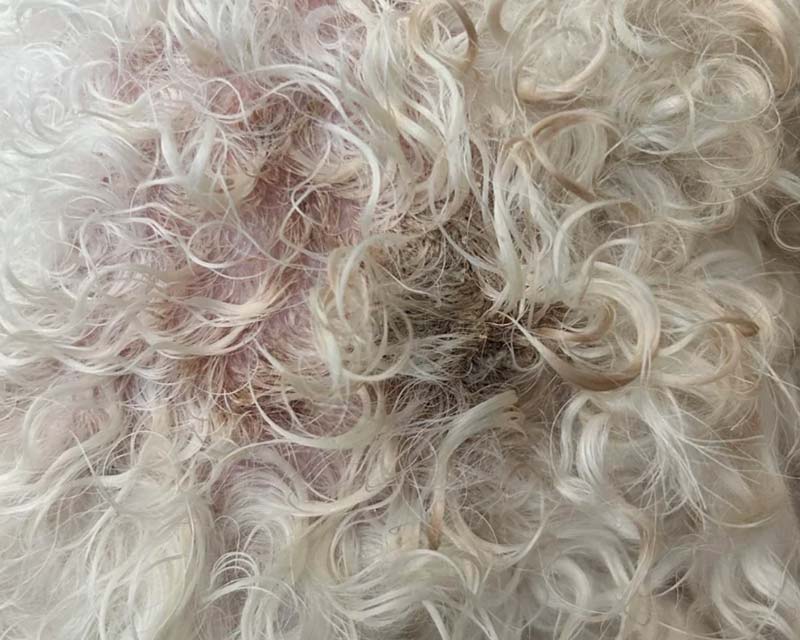
How Is Seborrhea in Dogs Treated?
Seborrhea is typically treated with medicated shampoos. These shampoos typically contain coal tar, sulfur, selenium sulfide, salicylic acid, phytosphingosine, and benzoyl peroxide to remove excess scale and dead skin while degreasing the coat.
If there is an underlying bacterial or fungal infection, regular bathing with antibacterial or anti-fungal shampoo with chlorhexidine, ketaconazole, or miconazole. Your vet may prescribe oral or topical antibiotics or anti-fungals to be taken for 3-4 weeks until the infection clears. Lavengel® can also be of use in countering bacterial pyoderma lesions.
On top of that, your dog's ears will likely need to be cleaned every 2-3 days with a medicated ear cleaner. If your dog has an otic (ear) infection, an ear medication may be prescribed as well.
Your vet may also prescribe oral medications such as omega-3 fatty acids, zinc, Vitamin D, Vitamin A, cyclosporine, and steroids to help manage seborrhea.
Photo: Seborrhea patch with yellow crust, via r/reddyfreddy23 on Reddit
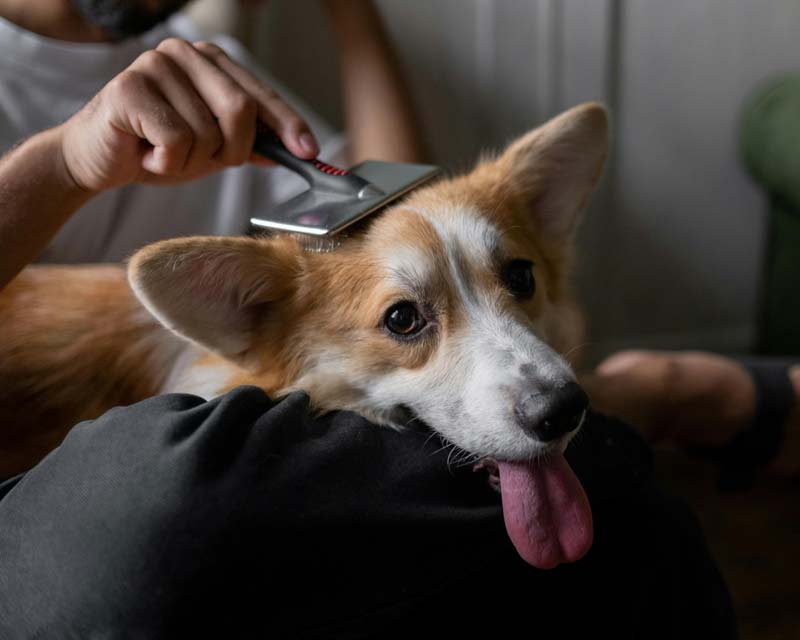
Are There Any Home Remedies for Seborrhea?
For any severe or lingering case of seborrhea - or any skin condition for that matter - we always recommend consulting your veterinarian.
A few ways you can help prevent or manage seborrhea at home are:
- Regular bathing with an anti-seborrheic shampoo containing coal tar and salicylic acid, paying attention to areas such as skin folds.
- Regular hair brushing to remove dead hair and skin
- Weekly ear cleaning
- Supplementing their food with Omega-3 fatty acids
- Feeding them a healthy, well-balanced diet and being aware of any food allergies
- Routine vet visits
Quick Canine Seborrhea FAQs
Is seborrhea contagious?
No, seborrhea cannot be spread to other dogs or humans.
Does seborrhea cause fur loss?
It can cause hair loss, yes.
It's very important that you consult with your vet, as they can run the necessary tests to determine that the hair loss is not being caused by other factors. For example, demodicosis (demodectic mange), yeast infections, severe atopic dermatitis, and autoimmune disorders can also cause fur loss.
What would seborrhea smell like?
Seborrhea oleosa can have a strong musty odor that smells like unwashed dog, grease, or corn chips.
As a somewhat related note, it is normal for your dog's feet to have a light, "Frito" corn chip smell.
How long does it take to get rid of seborrhea?
Secondary seborrhea can take several weeks to clear up and requires frequent bathing to remove the excess keratin and cleanse the skin.
A bathing regimen should be set up by your vet, but it may require a bath every 2-3 days, then decrease to once every 1-2 weeks, depending on the severity. If a separate infection is present, it must clear first or the problem will resurface.
All dogs with primary seborrhea require lifelong management of the condition.
Can only certain dog breeds get seborrhea?
Secondary seborrhea can happen to any dog at any age. It does tend to be more common in breeds with skin folds and dogs with hormonal imbalances, frequent allergies, and autoimmune disorders.
Primary seborrhea, a genetic disease, is most commonly seen in:
- Cocker spaniels
- West Highland White Terriers (westies)
- English Springer Spaniels
- Basset hounds
- Dachshunds
- German shepherds
- Golden Retrievers
- Labrador Retrievers
My dog has a lot of dandruff. How do I know it's not seborrhea?
The only real way to tell if your dog has seborrhea is via veterinary diagnosis.
Because it can be similar to other skin conditions, and often arises due to an underlying issue like an infection, the best thing to do is consult with your vet to be sure.
Another possible cause of excessive dandruff is an infestation of Cheyletiella mites, also known as walking dandruff. Again, only a veterinary diagnosis can confirm this.
See our Canine Walking Dandruff Resource for more info.
See Other Canine Skin Conditions
-
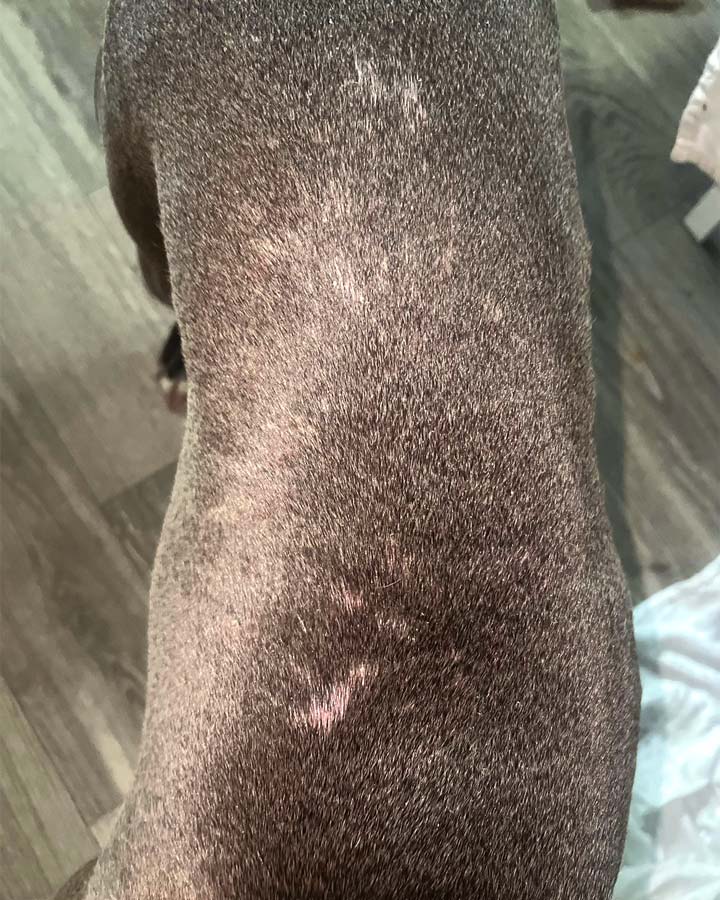
Walking Dandruff
More like dand-roughAlso known as cheyletiellosis, this skin disease is caused by an infestation of mites and can be a contributor to seborrhea.
-
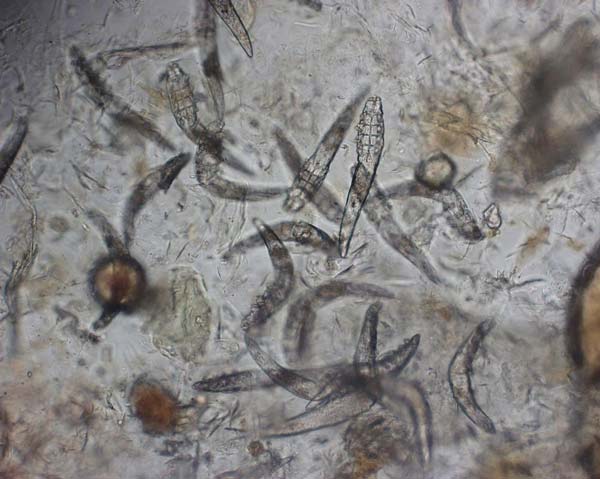
Mange
Mite be worth learning aboutMange is an uncommon, yet serious disease caused by parasitic mites. There are two forms - demodectic and sarcoptic.
-
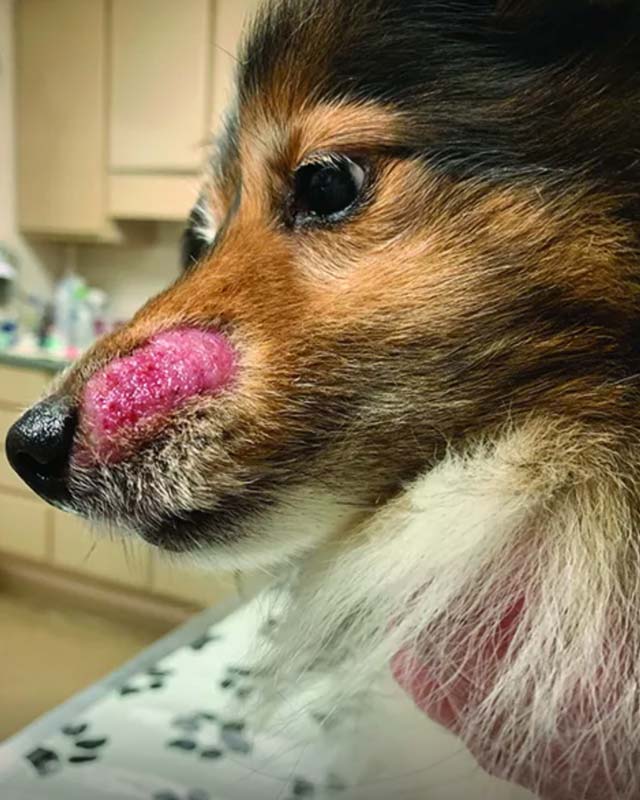
Ringworm
Not a worm, but a germ?Ringworm, also called dermatophytosis, is a contagious (even to humans) skin disease caused not by a parasite, but a fungus.



